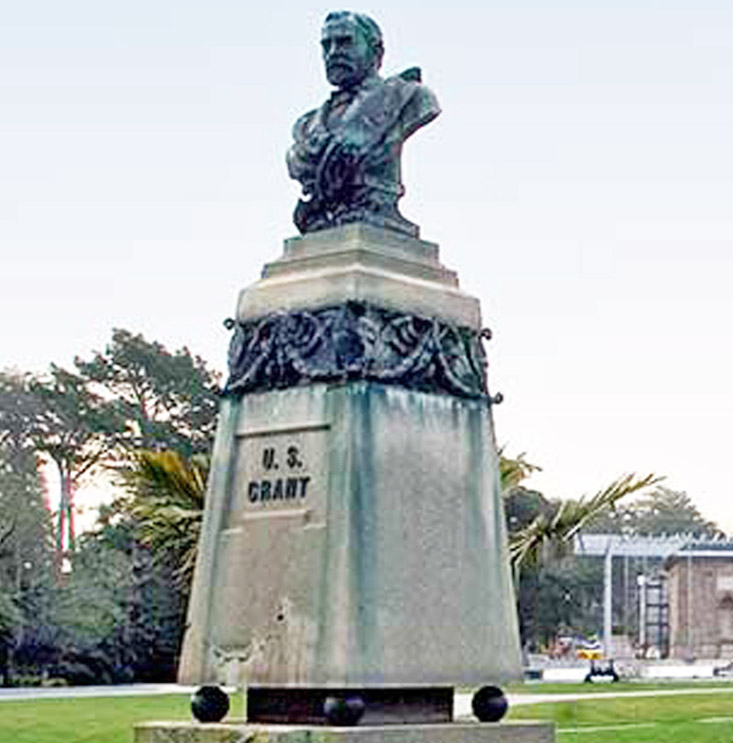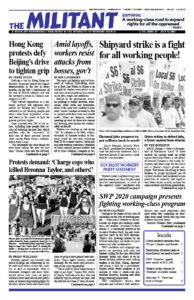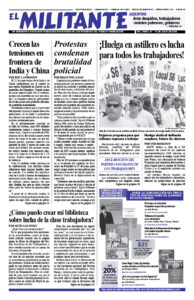Worldwide protests against police killings in recent weeks reflect the depth of opposition to cop brutality and racist discrimination among working people today. The protests have made some gains, leading to charges against cops and racist vigilantes and strengthening the unity of the working class. But some middle-class radicals and antifa groups have tried to divert these fights into destroying statues and other symbols of figures from past history they call “oppressive.”
In fact, these forces try to use the cover of large protests elsewhere to organize small bands to try and tear down the statues, with backing from the liberal “woke” press, like the New York Times. They threaten to silence anyone who disagrees, and aim to rewrite history and obscure the development of the class struggle that has marked social evolution. Without this working people can’t understand the class roots of historical development and find a road forward to overthrow class exploitation and oppression once and for all.
The editors of the Washington Post pontificate that those who object to destroying monuments “we don’t like” in effect endorse the “atrocities” carried out by the figures depicted in the statues — a form of race-baiting. If the statues have to remain, the Post editors say, working people can’t be trusted to know anything about them, and the statues should be covered with warnings and tracts to enlighten people about the evil they depict.

Some arguments go far beyond objections to statues of historical figures whose families owned slaves or held other views now discredited. Laura Brodie writes in the New York Times that all statues of historical figures on horseback portray “toxic masculinity” and are candidates for destruction.
These calls follow the destruction of statues in San Francisco’s Golden Gate Park June 19 of former President Ulysses S. Grant — the commanding general of the Union army that defeated the slavocracy in the Civil War and was elected president to enforce postwar Radical Reconstruction — and other figures in U.S. history. Even a statue of Miguel Cervantes, who had been held as a slave and was author of Don Quixote, was vandalized. A number of nearby structures were marked with the symbol of area antifa groups.
The American Museum of Natural History, backed by New York City authorities, decided to remove the statue of former President Theodore Roosevelt.
You can’t ‘cancel’ history, we need it
Behind the destruction and removal of monuments lies the notion that by erasing symbols from the past, reflecting different stages of class development, you can “cancel” them and pretend they didn’t happen.
Eradicating the record of slavery, a historical epoch that was key to the development of capitalism, and with it the development of the modern working class, in order to avoid something that is “hurtful,” does nothing to help working people learn how historical changes are made nor from seeing ourselves as the makers of history.
Frederick Engels, a founder of the modern working-class movement, took these questions up in his criticism Anti-Duhring, published in 1878, after the U.S. Civil War that overthrew the slavocracy. “It is very easy to inveigh against slavery and similar things in general terms, and to give vent to high moral indignation at such infamies,” he wrote. “Unfortunately all that this conveys is only what everyone knows, namely, that these institutions of antiquity are no longer in accord with our present conditions and our sentiments.”
“Without slavery, no Greek state, no Greek art and science, without slavery, no Roman Empire. But without the basis laid by Hellenism and the Roman Empire, also no modern Europe. We should never forget that our whole economic, political and intellectual development presupposes a state of things in which slavery was as necessary as it was universally recognized,” he said. “In this sense we are entitled to say: Without the slavery of antiquity no modern socialism.”
The working class has an interest in developing a long view of history — understanding how civilization emerged from the earliest toolmakers; how exploitative social systems developed as ruling classes subjugated the toiling majority; and especially how human progress is driven by inevitable rebellions of slaves, serfs, laborers and other oppressed classes throughout history. Through revolutionary struggles more advanced social systems replace outmoded ones.
The bosses and their government want us to believe that people are inherently greedy and capitalism will last forever. But history teaches that the working class and its exploited and oppressed allies are capable of uniting to overthrow dog-eat-dog capitalism, transforming ourselves in the process, and taking political power into our own hands. This will be the mightiest weapon possible for working people to carry forward the battle to end Black oppression and every form of human degradation inherited from millennia of class-divided society.
The Confederate battle flag came down
There is no broad working-class movement today demanding Confederate symbols be taken down as part of advancing the working-class struggle against racist violence. But there have been times when this has been important. In 2000 some 50,000 people marched in Columbia, South Carolina, demanding that the Confederate battle flag be taken down from the state Capitol Building. They urged that the flag, a symbol not of past slavery but a banner for racist Klan violence, be removed from the Capitol grounds.
At the end of June this year the government in Mississippi voted to take down its flag — the last state symbol flying in the country containing the Confederate battle flag.
This is a blow to any who would seek to organize racist violence today.
Knowing the real history of past class struggles is key to charting a road forward. Along that road working people will decide what statues and other historical monuments we want to keep and where, and what new ones to erect.
We don’t need small self-appointed groups imposing their own will on others tearing down statues, putting barriers in front of working people learning from our history, and gaining confidence in what we can become.

